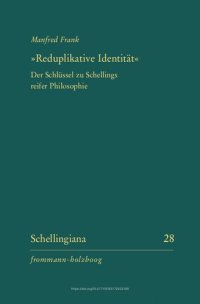
Ebook: Reduplikative Identitat: Der Schlussel Zu Schellings Reifer Philosophie (Schellingiana) (German Edition)
Author: Manfred Frank
- Year: 2018
- Publisher: Frommann-Holzboog
- Language: German
- pdf
English summary: It was not until the publication of Schelling's Munich and Berlin lectures that we learned the decisive source for his theory of an identity of identity or identity doubled in itself. Schelling referred to what he called an older logic that was still acquainted with the figure of reduplication, for instance in Leibniz and Wolff. Philosophers in this tradition employed this term to refer to the specification of an aspect under which the subject-term is being considered. An often quoted example: As consul, Fabius Maximus has authority over his father, but as son he stands under his fathers authority. Schelling gave the following turn to reduplication: Nature as nature does not coincide with the mind; and the mind as mind does not coincide with nature. Both have different truth conditions, so as to integrate an essential moment of difference into the identity formula. There is an X, however, which is strictly (seamlessly) identical with itself (the absolute subject = X) while transitively being both of them in turn; and it is only via X that the relata (nature and mind) are indirectly identified with each other: X is B and X is A (and X is strictly identical to itself). In addition to this, Schelling held a view of predication as kind of identification. He became acquainted with this view at the Tubingen Seminary through his teacher Gottfried Ploucquet. This insight helps us understand why Schelling reasonably thought that the identity-formula A=A is the genuine matrix of all veridical judgments. Taken together with his conviction that judging (Kant's relative position) is a minor (or inferior) form of existential being (Kant's absolute position) sheds light on why in 1806 Schelling made the radical contention in his Aphorisms: The strict sense of being (absolutely posited seamless self-sameness) is taken over by the looser sense of the copulative is which identifies subject and predicate; yes, this copula alone is existence itself and nothing else. Why should Schelling's conception of nature-mind identity interest recent philosophers of mind? Because Schelling presents an ontologically neutral solution: Identity is a symmetrical relation that does not favor mind or matter, and prevents the idealistic reduction of nature to the mind. Nor can we conceive of the nature-mind identity as a fact inwardly disclosed to the mind (McGinn, Levine). Consciousness remains an enigma for itself; so does its identity with nature. Schelling teaches us that identity theories are not justified by self-evidence, but by an inference to the best explanation. German description: Nie ist genau erklart worden, was Schelling unter Identitat von Natur und Geist verstand. Dabei hat er sein reifes Denken Identitatssystem genannt und sich zeitlebens um kein zweites Problem begrifflich ahnliche Muhe gegeben. Da er aber seine Uberlegungen in Schriften verpackte, deren grosser systematischer Ausgriff sie schier erdruckte, ist, was er bis hinein in die Weltalter-Periode daruber herausfand, kaum eigens gewurdigt oder auch nur klar benannt worden. Die Schellingliteratur arbeitete entweder historisch oder liess sich vom Systemgedanken oder einzelnen in die Augen springenden Problemen blenden (z. B. Natur, Organismus, Freiheit, Existenz). Dabei ist Schellings Starke in einzelnen entscheidenden Argumenten versteckt, die, waren sie bekannt, die gegenwartige, auch analytische Diskussion durchaus zu inspirieren vermochten. Wir konnen heute urteilen, dass schon der junge Schelling in seiner Schrift Form der Philosophie eine differenzsensitive Form der Identitat im Sinn hatte, die er in den kommenden Jahrzehnten immer genauer auszubuchstabieren unternahm. Seine eigentlichen Quellen hat er kunstvoll verborgen. Es sind erstens die Identitatstheorie der Pradikation seines Universitatslehrers Ploucquet, die den Stiftlern in Tubingen eingeblaut wurde und die ihre merkwurdige Fixierung auf die ganz unkantische Auffassung vom Urteil als Subjekt-Pradikat-Identifikation (mit quantifiziertem Pradikator) erklart. Und zweitens Schellings Entdeckung einer alteren Logik, die mit der Figur der reduplicatio arbeitete. - So auch das Absolute: Als Geist ist es nicht Natur (und umgekehrt; Aussagen uber beide haben unterschiedliche Wahrheitsbedingungen), aber Geist und Natur werden beide vom Absoluten gewesen (transitiv ins Sein gehoben), und dies Absolute ist im striktest denkbaren Sinne mit sich identisch. So lasst sich die Schelling'sche Formel von der Identitat der Identitat und Differenz dem gesunden Menschenverstand vermitteln und Schellings aufrichtiger Jugendgedanke (Marx) aktualisieren. Er schneidet respektabel ab im Wettbewerb mit allerlei heutigen Leib-Seele-Identitatstheorien.
Download the book Reduplikative Identitat: Der Schlussel Zu Schellings Reifer Philosophie (Schellingiana) (German Edition) for free or read online
Continue reading on any device:

Last viewed books
Related books
{related-news}
Comments (0)